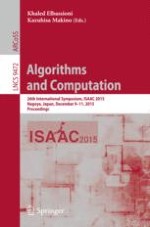This book constitutes the refereed proceedings of the 26th International Symposium on Algorithms and Computation, ISAAC 2015, held in Nagoya, Japan, in December 2015.
The 65 revised full papers presented together with 3 invited talks were carefully reviewed and selected from 180 submissions for inclusion in the book. The focus of the volume is on the following topics: computational geometry; data structures; combinatorial optimization and approximation algorithms; randomized algorithms; graph algorithms and FPT; computational complexity; graph drawing and planar graphs; online and streaming algorithms; and string and DNA algorithms.
